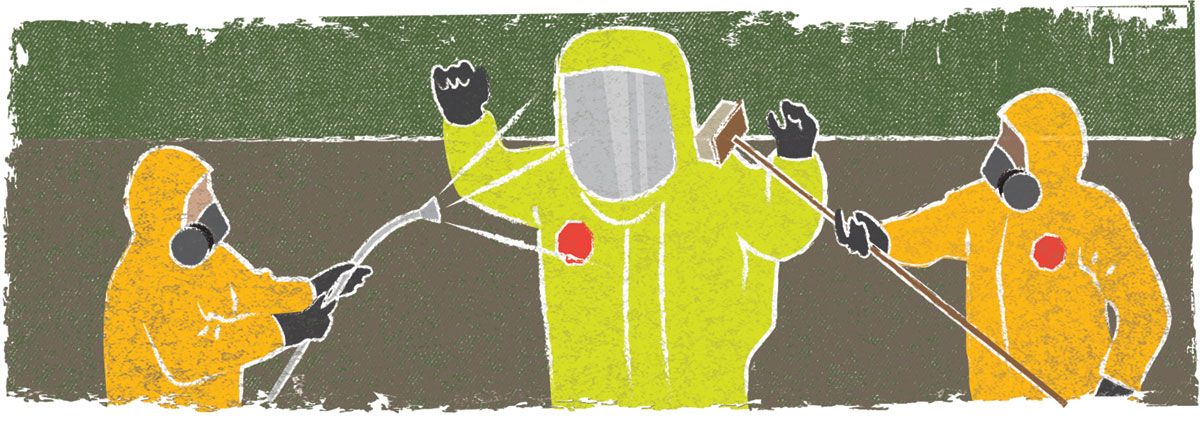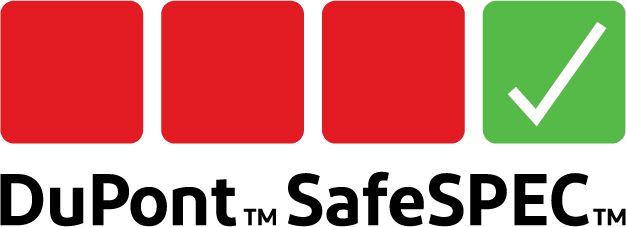Emergency Services: Public versus Private
By Robert E. Lukhard
Chief of Emergency Services, DuPont Spruance Plant

After serving more than 35 years with municipal fire and EMS departments, I retired from public service and became Chief of Emergency Services at the DuPont Spruance Plant in Chesterfield County, Virginia. Since my retirement, several people have asked me, "Chief, what's the difference between working in the private sector and working in local government?"
Well, the fire service is the fire service—the wet stuff goes on the red stuff the same way and the fire goes out. Not to say there aren't differences; there are. For me, many of the interesting differences pertain to the hazmat side of the business. In the municipal world, you must be prepared to respond to all types of hazmat situations, and you're often dealing with totally unknown chemicals. The industrial world is a bit different. In most cases we not only know what the chemical is, but we have the SDS at our fingertips. We are familiar with the containers, quantities and techniques for dealing with situations.
Resources are another difference. On the industrial site we have chemists, engineers and technical experts ready to assist during an incident. In the municipal world, it often takes a fair amount of time to figure out what you're dealing with, who owns it, and who is willing to help with technical information.
In many hazmat incidents, mechanical damage to a container is the cause of the leak or spill. In the public sector, transportation incidents account for a large portion of hazmat incidents. In these incidents, speed often is the factor that determines the amount of damage to a container and the potential for release of a chemical. On the industrial side, speed usually isn't a concern. However, there is typically a lot of moving, lifting, loading and unloading of containers and products, which can create situations that can result in container damage and a release. Most process chemicals are contained and have secondary containment in place or readily available.
The fire brigade on the industrial side operates similarly to fire departments on the municipal side. Safety precautions and National Fire Protection Association (NFPA) and Occupational Safety and Health Administration (OSHA) compliance are required in both worlds. The industrial fire brigade members fill the same roles in the Incident Command System as municipal firefighters and officers do: IC, safety officer, division and group supervisors, etc. The rank structure also is very similar, with both organizations usually having chiefs, captains, lieutenants and firefighters.
Typically, staffing is the biggest difference. In most municipal fire departments, officers and firefighters are full-time employees. Industrial fire brigade members are volunteers who work on the industrial site as operators or maintenance personnel. When there is a fire alarm they leave their assigned job and respond to the emergency as fire brigade members.
A couple of themes are common in both worlds. First, having the right type of personal protective equipment (PPE) available and knowing how to properly don, decontaminate and doff is very important for all emergency responders. Second, training and exercises are extremely important for being prepared to respond to and mitigate incidents in a safe and efficient manner.
NFPA Hazmat Standards: New Editions
By Daniel Bowen
Technical Specialist (North America), DuPont Personal Protection

Last year saw the release of new editions of all three of the National Fire Protection Association (NFPA) hazmat standards, NFPA 1991, 1992 and 1994. This article identifies some of the significant changes made to these standards as they pertain to chemical protective clothing.
It is important to understand that NFPA standards represent the minimum performance requirements a given manufacturer's garment must meet to be certified. Just because a garment meets the criteria for one or more of these standards does not mean it will necessarily protect wearers for any given situation. It is imperative for users of chemical personal protective equipment (PPE) to conduct a thorough hazards analysis for their range of exposure scenarios and select PPE that addresses their specific needs.
NFPA 1991, 2016 edition: The 2016 edition includes a number of significant changes, the first being the title and scope. The new title is "NFPA 1991 Standard on Vapor-Protective Ensembles for Hazardous Materials and CBRN Terrorism Incidents." Distilled mustard (blister agent) and soman (nerve agent) have been added to the list of challenge chemicals required for certification. The chemical resistance portion of the standard has been changed from breakthrough time to cumulative permeation. Prior editions required no detectable chemical breakthrough in one hour or less for a battery of challenge chemicals. The 2016 edition changes this to a maximum cumulative permeation in one hour of 6 µg/cm2 for toxic industrial chemicals (TICs), 4 µg/cm2 for distilled mustard and 1.25 µg/cm2 for soman. The technical committee made this change, believing it to be a more meaningful measure of barrier material performance.
A few changes to the standard pertain to the physical aspects of garment configurations. The first is the elimination of the use of a second overgarment to meet the standard—all NFPA 1991 garments must now be "single skin" configurations. Next, tape can no longer be used during the certification testing process—garments must incorporate sufficient design components to pass certification testing without the use of tape. Zippers have been identified as a potential weak point in suit design and must now be protected with covering systems. Many of these garments incorporate glove systems that include multiple layers.
Included in the 2016 edition is a requirement for wearers to be able to remove and reinsert their hands five times in two-and-a-half minutes or less. A visual acuity test has been added that includes what is essentially a range of vision test where test subjects look up, down, left and right at a test card, and the visor material now has an impact test, replacing prior physical strength tests. While there are a number of other changes to NFPA 1991, these are the ones that are probably the most important to garment wearers.
NFPA 1992, 2018 edition: It is important to remind readers that NFPA 1992 is specific to liquid splash hazards and does not address hazardous material incidents where the hazardous material is present as a gas or a vapor-producing liquid at concentrations known to be toxic to the skin. Of equal importance is the reminder that the chemical resistance test procedures included in NFPA 1992 are penetration and not permeation. Once again, it is imperative that users of chemical PPE conduct a thorough hazards analysis for their range of exposure scenarios and select PPE that will address their specific needs.
As for specific changes to the standard, the first is a complete revision of the challenge chemicals used. The previous revision included seven industrial chemicals; the 2018 edition increases the number to nine, with some substitutions being made to utilize challenge chemicals known to be aggressive to polymers.
There have been many changes to the standard that pertain to gloves and footwear, but those changes are outside the scope of this article. There are also numerous changes to the test methods required for certification, but because those have little impact on the wearer of the garments, they will not be addressed here.
One area that may be of interest is the inclusion of requirements for reporting evaporative resistance and insulation values together with heat loss for products designated as "breathable." Garments positioned as "breathable" will have a label stating that claim and will have data that includes measures of heat loss, insulative value and evaporative resistance (apparent and total).
NFPA 1994, 2018 edition: There have been many major changes in the latest edition of this standard, the first of which is the inclusion of hazardous materials incidents in the scope. Previous editions of NFPA 1994 were specific to chemical, biological, radiological and nuclear (CBRN) incidents, but the latest edition includes more common industrial chemicals in the test battery, extending the applicability of the standard beyond CBRN incidents.
There have also been major changes to the classes of garment configurations, expanding the options to seven classes from the previous three. Class 1 has been reintroduced with this edition, and there are both "standard" and "ruggedized" options for Classes 2, 3 and 4. Ruggedized versions of garments have higher physical performance components than standard ones, with test methods being the same but the performance requirements being higher—for example, burst strength requirements for Class 2 standard garment fabric is 35 lbf, while the requirement for Class 2R (ruggedized) is 45 lbf. Similar to the latest edition of NFPA 1992, NFPA 1994 2018 includes data reporting requirements for garments advertised as breathable. Class 2 garments have the option to be breathable and report heat loss data; Class 3 and 4 garments must include heat loss/evaporative data.
When it comes to chemical-resistance performance, wearers must be aware of one key point—this standard was developed for first responders who may need to function in a contaminated environment but not come in direct contact with concentrated amounts of hazardous materials. This is an area where the NFPA 1994 standard is often misunderstood. Although the range of chemicals included in the test battery is thorough, wearers must be aware that the concentrations tested are quite low. Liquid chemical challenge tests are conducted at 20 g/m2 for Class 1 and 10 g/m2 for Classes 2 and 3. To put this in perspective, an ounce of water weighs just under 30 grams. Now, spread two-thirds of an ounce of water over a square meter of material—this provides a representation of the quantity/concentration of materials used in liquid chemical resistance testing of NFPA 1994 materials.
For vapors/gases, Class 1 garments are tested at 10,000 ppm, which equals a 1% concentration; Class 2 at 350 ppm, which equals 0.035%; and Class 3 at 40 ppm, which equals 0.004%. Once again, just because a garment meets the certification criteria of a particular standard doesn't mean it will protect wearers in any given situation. It is imperative that wearers conduct a thorough analysis of the hazards they will face and select PPE that will provide adequate protection.
Additional changes to the latest edition are an increase in the concentration of the chemical used in the MIST (man in simulant) test, additional physical requirements for footwear, changes to the visor material test (where applicable), hand insertion into gloves requirements (similar to NFPA 1991), and visual acuity testing (once again, similar to NFPA 1991).
This summary doesn't identify every change between previous editions and the current ones, but it does attempt to identify those changes that may be of interest to wearers of certified garments. We hope you've found this information useful. If you have questions, please contact us at your convenience. We'll be glad to help.
Back to Top
After Maria: Dispatches from the Puerto Rico Hurricane Response
By Kevin Chambers
Hazardous Materials Specialist, NY-TF1, FEMA; Hazardous Materials Specialist, FDNY

On the evening of September 19, 2017, I was working a night tour at the Fire Department of the City of New York (FDNY) Hazardous Materials Company 1 in Queens, New York. About 1,600 miles away, Hurricane Maria was ravaging everything in its path and increasing in strength to a Category 5 hurricane. Several hours later the storm would collide with Puerto Rico as a Category 4 hurricane with winds exceeding 155 mph, setting in motion the worst natural disaster in the island's recorded history. At around 3 a.m. the next day, my lieutenant informed me that New York Task Force 1 (NY-TF1), of which I am a member, had been activated. I would be deploying to Puerto Rico as one of the team's Hazardous Materials Specialists. I was instructed to grab my go-bag and report to the Federal Emergency Management Agency (FEMA) cache in Brooklyn.
NY-TF1 is one of 28 Urban Search & Rescue Response (US&R) Teams across the nation that are coordinated and overseen by FEMA. NY-TF1 is made up of highly trained individuals from the FDNY and the New York City Police Department (NYPD), each with their areas of expertise, including: rescue; communications; emergency medicine; planning and logistics; structural engineering; and hazardous materials. The team is ready to deploy to anywhere in the country within six hours and is able to be fully self-sufficient for the first several days upon arrival. Depending on the type of mission, the personnel and equipment can be scaled up or down. For the Puerto Rico response, we deployed as a Type IV team consisting of 28 members. (Approximately one month earlier, I'd deployed to Texas with an 80-member Type I team for Hurricane Harvey response.)
After all team members had assembled at the cache, we grabbed any last-minute items we needed. Most of our equipment and tools were palletized and ready to go. Normally, the next step would have been to depart for our final destination. However, since the location of the incident was an island without power and virtually no air traffic, finding transportation for 28 members and a few trucks' worth of equipment wasn't easy. With some luck, the U.S. Air Force offered to help. Soon we were up in a C-17 heading for Puerto Rico as the sun began to set. It was my first experience on a C-17 and I was quite excited. As we approached San Juan, though, my excitement faded quickly. With few exceptions, Puerto Rico was dark. It was sobering to realize that an island of more than three million residents was without electricity.
Deep into the night, we arrived at our hotel in San Juan. Walking in was a surreal, post-apocalyptic experience. The entire hotel had been transformed into FEMA's Base of Operation (BOO). Members from other US&R Teams were sprawled out, claiming different sections of the floor for sleeping. Force protection from various federal law enforcement agencies was there to accompany us and provide protection during our missions. They were strolling around in body armor, carrying semi-automatic rifles. Ironically, what seemed most out of place were the intoxicated tourists sitting at the hotel bar. They mumbled some obscenities as we walked in, probably out of frustration over their situation. We dropped our gear, claimed a space and slept for a few hours.
One of our first tasks was to establish a Technical Decontamination site outside of the hotel for returning teams to use each night. It was critical to properly decontaminate ourselves before entering the hotel, as well as our gear for safe use the following day. Much of the water we operated in throughout our deployment was awash in hazards like sewage and fuel. After establishing the decon site, we searched the hotel for rooms to sleep in for the next two weeks. Mold had already become an issue, so a few of us spent the day ripping up rugs and carrying out water-damaged furniture. We then used a pump sprayer with a hypochlorite solution to decontaminate the area.
Each morning our team leaders would receive orders for the day from our incident commander. Based on those orders, we decided what equipment to bring considering the limited space available in the vehicles. It was imperative to bring everything we needed for the day because returning to the BOO to gather additional supplies and equipment was not an option, nor was running to Home Depot. We had to bring the proper personal protective equipment (PPE), tools, equipment, meals ready to eat (MREs) and water with us or the day would be wasted. The roads were treacherous, and each day it was a challenge to reach the location in which we needed to operate. Downed street signs, traffic lights, trees and mudslides all contributed to the extremely difficult travel. We encountered massive trees blocking roads and cutting off entire towns from access to fuel and supplies. Often we witnessed residents attempting to clear downed trees using machetes, an impossible task. We would go to work with our chainsaws, clear the road, and push forward toward our final destination.
Although decon was stressed throughout our stay and air monitoring was performed at times, this wasn't a "hazmat-heavy" deployment. The first few days after our arrival, most of the emphasis was on rescue. It was a priority to locate civilians who were elderly, ill and disabled and remove them to an area of refuge. We were able to assist with the evacuation of several residents of Utuado, a town with a population of around 30,000. Located in a rural, mountainous region, part of Utuado had been isolated due to a complete bridge collapse from floods during the hurricane. The bridge was a lifeline for many of the residents and the only means of access to many homes in the town. Although the floodwaters had receded a bit, we still had to contend with a rapidly moving river. After setting up a high line to the other side, team members donned water-rescue suits and traversed the river. We went from home to home looking for civilians in need of evacuation and then ferried them across. I spent several days in Utuado and got to know several of the residents. I soon realized what a small world it is when I discovered that some of them had lived in New York City (NYC) and were familiar with many of the same places. They had retired and escaped the fast-paced life of NYC for the mountains of Puerto Rico. Now, they were concerned about their decision and feared it might be years before the bridge to their town was rebuilt.
After evacuations were complete and other priorities—such as restarting a backup generator for the local hospital—were resolved, we needed to assist with the distribution of food, water and medicine. This was difficult because of the lack of accessible roads. We played a vital role in the distribution of supplies to some people because we were equipped with chainsaws and jeeps, which allowed us to reach areas that had been unreachable before. At times, we had to ferry supplies across rivers, much as we had done in Utuado.
As operations began to wind down and some of the other task forces had departed, we were given the order to demobilize. Finally, I had time to reflect on the deployment. I realized that media accounts regarding the response to Hurricane Maria were somewhat at odds with my "boots on the ground" impression of what had occurred. Puerto Rico had experienced the worst natural disaster in its history, and I was genuinely impressed by how well the island's residents had come together to deal with this overwhelming event. I saw countless examples of neighbors helping neighbors, patience instead of frustration, and people taking action to help themselves and others. I'm proud of the work that NY-TF1 accomplished and feel fortunate to have been able to support it. As the island moves forward to the next stages of recovery, I hope that Puerto Rico's people are not forgotten and that they continue to receive the assistance they require.
Author's note: While writing this article, I was pleased to hear that the bridge in Utuado had been rebuilt six months after Hurricane Maria.
Back to Top
Hazmat Through History: Oil Spills
By Daniel Hammel
Garments Inside Sales Manager, DuPont Protection Solutions
 Print
Print
Oil spills can occur at any step of the oil-production process, including during drilling, refining and transporting. Spills can be caused by a pipeline break, a grounded or crashed ship, or an oil rig explosion, among several other possibilities. Some oil spills even occur naturally as oil is released from the seafloor.
Thousands of oil spills occur every year across the globe. The largest oil spill in history was actually a deliberate act. In 1991 during the Gulf War, Iraqi forces poured more than 250 million gallons of oil into the Persian Gulf as they fled Kuwait. Their intent was to prevent the U.S. Marines from landing. The result was an oil slick as thick as five inches that covered 4,000 square miles.
One of the most notorious spills occurred in 1989, in Alaska's Prince William Sound, when the tanker Exxon Valdez struck a reef and spilled more than 10 million gallons of oil over several days. The remoteness of the location made emergency response particularly difficult. The oil eventually covered 11,000 square miles, including 1,300 miles of coastline.
The Exxon Valdez oil spill wreaked havoc on wildlife and the marine environment. The death toll included at least 100,000 seabirds, thousands of otters, hundreds of seals and bald eagles and more than 20 whales. When oil coats their feathers or fur, animals are not able to trap in heat and may die of hypothermia. Additionally, oil is highly toxic and can kill animals that inhale the fumes or absorb the toxins through their skin.
The cleanup process after a devastating oil spill often includes rescuing affected animals. Survivors are fed, hydrated and rested for about two days before the oil is cleaned from them, which may take several rounds of baths. Depending on their condition, cleaned animals may be released back to the wild several days or even months later.
To find out which DuPont products offer suitable protection for oil spill response, visit www.SafeSPEC.DuPont.com.
Join the DuPont™ Tychem® Trainer Advantage Program
By Daniel Hammel
Garments Inside Sales Manager, DuPont Protection Solutions

Looking for a way to keep your hazmat training program up to date? The DuPont™ Tychem® Trainer Advantage Program (TTAP) provides support for first responder training facilities across the United States. TTAP offers excellent equipment, technical support and some of the most advanced materials available to enhance the training experience. We believe that how you train isn't just important, it's critical. To find out more about program requirements and the benefits of becoming part of the TTAP community, please contact Cynthia.Rives.Bowen@dupont.com.
Products and/or sales questions?
Share your stories, tips and tricks.

Resource library
Find technical information, videos, webinars and case studies about DuPont PPE here.


